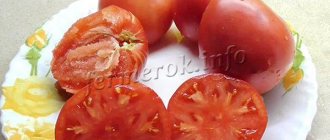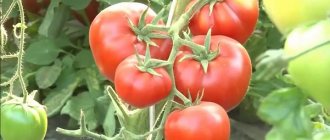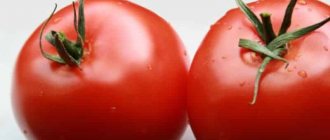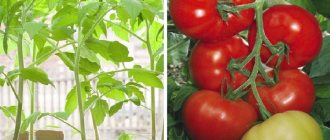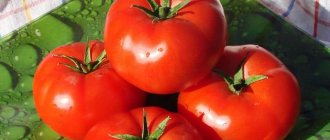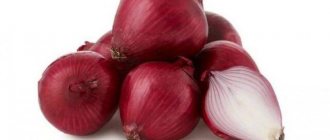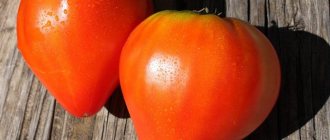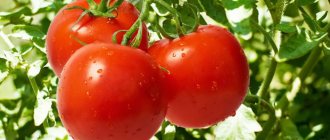» Vegetable growing » Tomatoes » Tomato variety Bull's forehead
0
1129
Article rating
Experienced gardeners have long distinguished the Bull's forehead tomato from other varieties because of its very large, fleshy and extremely tasty fruits. Considering its resistance to weather conditions, pickiness, and excellent yield, it can truly be called one of the best among tomatoes.
- Landing Features
- Care
- Advice from gardeners
- Seed selection and preparation
Tomato variety Bull's forehead
Description and characteristics of the variety
Tomato Bull's forehead is an indeterminate tall variety. Produces high-quality seeds that can be used for subsequent plantings. The shoots reach a height of 1.6-1.8 m and need shaping and staking.
The fruits are large, bright red with glossy barrels. The shape is round, slightly flattened on the sides. The taste of tender tomato bliss is sweetish with a slight sourness. There are only up to 5 seed chambers.
Tomato from is intended for open and closed areas. It is resistant to fungi and bacteria. Highly productive, yields up to 18 kg per m2. The weight of giants can exceed 600 g. The cut flesh is fleshy and juicy.
Minusinsk bullhead tomatoes are unpretentious in cultivation; with good care, they yield more than 10 kg in open beds and more than 16 kg in greenhouses per 1 m2. Ripen 95-105 days after germination
Country of origin and year of registration
The proven variety is over 20 years old. Bred by Russian breeders and registered in 1995.
Which regions are best to grow in?
The variety was originally intended for the harsh Siberian climate in greenhouse conditions. Fruits excellently in the south in open beds, in Siberia and the Urals under film cover.
Diseases and pests
Diseases occur very rarely and mainly when growing conditions are violated, namely when bushes are waterlogged, or when preventive measures are ignored. When the first symptoms of disease appear, the bushes need to be treated with special preparations.
Bushes are often attacked by pests, especially when grown in open ground:
- Codling moth, white butterfly. They are fought with the drug “Lepidocid”;
- Greenhouse whitefly. They are saved from it with the drug “Confidor”.
Usually the preparations can be bought at any gardening store.
Features of cultivation and storage
It is grown traditionally - through seedlings. Plants aged 50-60 days are transplanted into beds. Plantings are not thickened: the optimal distance is 60 cm, no more than 2 bushes are placed per 1 m2.
Standard rules for caring for tomatoes:
- Regular watering 2 times a week, the norm is 3 liters per bush.
- Form into 1-2 stems, leaving no more than 7 bunches of tomatoes.
- Garter to high trellises, obligatory fastening and tying of heavy fruit-bearing clusters.
- Loosening against the crust.
- Mulching to retain moisture.
They are fed with superphosphate, saltpeter, and potassium salts. Water with a diluted infusion of humus 1:10.
Ripe tomatoes are stored in cool, dark rooms for up to 7-10 days. Keeping quality and transportability are below average.
Features of agricultural technology of tomatoes Bull's forehead
Although this tomato is not too demanding to care for, it will require some effort to grow it.
Landing
These tomatoes are usually grown in seedlings. To do this, seeds are sown in containers or boxes with a nutrient mixture 60-65 days before the expected date of planting in the ground. That is, if in the middle zone the time for planting tomato seedlings in greenhouses falls in the middle - end of April, then seedlings for this need to start growing in the middle - end of February. To plant tomatoes in open ground, which is usually done in early - mid-May, seeds for seedlings are sown in early - mid-March. In this case, the plants need to be planted in separate containers with a volume of 500 ml in the phase of formation of 2-3 true leaves. Seedlings ready for planting should have 5-6 true leaves and a height of 20-30 cm.
Seedlings ready for planting should have 5-6 true leaves and a height of 20-30 cm
The recommended planting scheme for Bull's forehead tomatoes is a two-line one with a distance between rows of 50 cm and an interval between plants of 80-100 cm (it is better to place them in a checkerboard pattern). Thus, with a bed width of 100 cm, the recommended planting density will be 2-3 plants per 1 m2.
When planting in open ground and there is a threat of return frosts, for the first time you can use a cover made of spunbond or film along arcs.
Shaping bushes and garter
Since the bushes of the variety are quite tall and carry a large load of harvest, before planting them you should worry about arranging supports to which the stems and individual clusters will subsequently be tied.
You can use individual stakes for these purposes, but I prefer hanging cords that I tie to the crossbars of the U-shaped supports. In my opinion, it is more economical and simpler. The structure is assembled once, and you can tie as many cords to it as you like. In the case of stakes, tying up individual heavy bunches is problematic. This type of garter is also convenient when forming a bush with 2-3 stems, which is recommended for the Bull's forehead variety.
Pinching is also a mandatory procedure for this tomato, since the bushes produce a large number of fruits even without additional shoots.
In Bullhead tomatoes, shoots should be removed regularly
Watering
Since the variety is drought-resistant, it can do without frequent watering. But, since it is large-fruited and high-yielding, it is better not to risk it and not let the soil dry out. The following irrigation scheme will be optimal:
- Plant the seedlings in the dirt and water them abundantly.
- After 2–3 days, the soil is loosened and mulched (you can use peat, straw, rotted sawdust, sunflower husks, etc.).
- Do not water for 2-4 weeks, which ensures the development of a good, powerful root system.
- Subsequently, tomatoes are watered at intervals of 7-10 days, depending on weather conditions.
Feeding
In order to get the stated amount of fruits, you should not neglect regular feeding. They begin 2-4 weeks after planting the seedlings in the ground, simultaneously with the resumption of watering. In the future, feeding intervals should be 2 weeks, alternating nitrogen with potassium-phosphorus.
Treatments
In order to prevent fungal diseases, tomatoes can (but this is not necessary) be treated several times with biological antifungal drugs. The most popular of them is Fitosporin M Tomato, which can be used without restrictions on the number of treatments, since it is not addictive in pathogens. In addition, the drug is a foliar feeding because it contains humic acids. Fitosporin can be used even during the fruit harvesting period, since it is non-toxic and not dangerous to humans.
Advantages and disadvantages
The tomato was bred by Siberian breeders back in 1995. During this time, he was tested by professionals and amateurs, and therefore earned universal approval. Its main advantages:
- Large fruits.
- Excellent taste.
- Resistance to traditional tomato diseases and adverse weather conditions.
- Heat resistant.
- High yield with minimal labor costs.
- It tolerates both high humidity and prolonged absence of water.
There are some disadvantages that also need to be considered:
- Poorly transported.
- Prone to cracking when overwatered.
- It spoils quickly.
- Not recommended for whole canning.
Landing rules
Bull's forehead tomatoes are planted in two ways: seeds and seedlings. Each option has its pros and cons. The seeded material produces tomatoes with stronger immunity. The procedure of transferring seedlings to open soil, which is painful for plants, is avoided.
Before sowing, the seeds are processed.
Seed preparation:
- Quality check. A prepared salty brine is prepared into which the seeds are poured. The floating seeds are removed as unsuitable for growth.
- Etching. The seeds are soaked in a 3% hydrogen peroxide solution for 10 minutes.
- Heat treatment. Cover the baking sheet with baking paper and place the seeds on top. Place in a hot oven (60°C) for 2-3 hours. The material is stirred regularly (every 20 minutes).
- Bioactivation. The seeds are kept in aloe juice for 12 hours, then dried in air.
- Germination of seeds. The procedure is not necessary, but seedlings will appear earlier.
Moisten a 3-layer bandage. The seeds are laid on top and kept at a temperature of 26-28°C. When the gauze dries out, add water. If the seeds hatch, they are transferred to the ground. Prepared seeds are sown in the ground or for seedlings.
Seeds
Place 3-4 seeds in one hole. Seed depth is 2 cm. Soil is poured on top and watered with warm water.
The distance between the seeds in the holes is about 3 cm, between the holes - 35-40 cm. Having finished sowing, the beds are covered with film. The shelter is removed daily for ventilation. Shoots will appear on the 12th day. When the soil dries, moisten it.
When the first 3 leaves appear, weak shoots are removed from each hole, leaving several powerful specimens. And after another 2 weeks, the most powerful sprout remains in each hole.
Seedlings
Sowing seedlings is carried out according to the following algorithm:
- Preparing containers. Use any dishes, boxes, containers. Agrofibre is laid at the bottom, then sawdust and small pebbles as drainage.
- Soil preparation. Ingredients: turf or leaf soil, humus, peat, a little sand.
- Calcination of the soil in the oven from bacteria and harmful spores. Or pouring boiling water on it.
- Watering the soil with settled water at room temperature.
- Deepening the seeds into the soil by 1 cm.
- Mulching with peat.
- Installation of film cover.
Keeping temperature in bright light is 25°C. The first watering is carried out with a light solution of manganese or boric acid (2 g per bucket of water).
The film is removed daily for ventilation, and after the seeds are pecked, it is removed. If there is not enough light, use a phytolamp or natural light, for which the seedlings are transferred to a balcony, winter garden, or another bright room. When 2-3 leaves appear, the seedlings dive. Before transplanting into the garden, the seedlings are hardened by keeping them in the air for 15 minutes a day.
Transplanting tomatoes into beds occurs at the end of May. The seedlings are 50–60 days old at this time. For 1 sq. m place 2-4 bushes.

